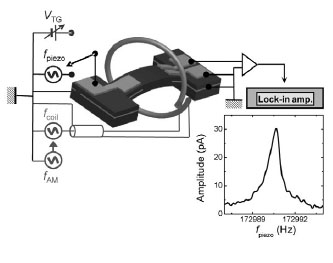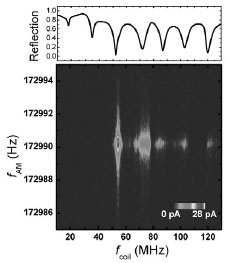Physical Science Laboratory
Electromechanical resonators with small mass and high quality-factor have
attracted intensive attention due to their potential applications as sensors
[1], signal processors [2] and to study macroscopic quantum phenomena [3].
Actuation of the electromechanical resonator is essential in order to access
the various mechanical functions. In the actuation methods reported so
far, mechanical oscillations were induced by directly applying a voltage
to an electrode on the mechanical resonator. The presence of the electrode
for these direct electrical actuations not only loads the resonator but
can also yield Joule heating which increases the mechanical energy dissipation
and thus degrades the resonator performance. In order to overcome these
obstacles, a contact free driving technique that does not need the direct
electrical actuation was developed [4].
A GaAs/AlGaAs-based mechanical resonator containing a two dimensional
electron gas (2DEG) and gold top-gates (TGs) was fabricated, which was
placed inside a coil operating in the radio-frequency (RF) range as shown
in Fig. 1. The mechanical resonator reveals the fundamental mode fres = 172990.5 Hz at less than 200 mK as shown in the inset of Fig. 1. The
coil shows a number of LC resonances (the upper panel in Fig. 2) and it emits RF waves to the mechanical resonator when the coil transmission is maximized. To demonstrate remote actuation using the RF waves, the mechanical response as function of the coil frequency fcoil ranging from 10 to 130 MHz was measured (the lower panel in Fig. 2). The
RF wave’s amplitude was modulated at frequency fAM and when fAM = fres, the mechanical oscillator resonated at frequencies that corresponded
to the LC resonances in the coil. The RF waves generated from the coil could drive
the mechanical oscillator to resonance. This driving scheme enables the
mechanical oscillations to be remotely induced and paves the way towards
new applications for electromechanical resonators.
[1] A. N. Cleland and M. L. Roukes, Nature 392 (1998) 160.
[2] I. Mahboob and H. Yamaguchi, Nature Nanotech. 3 (2008) 275.
[3] A. D. O’Connell et al., Nature 464 (2010) 697.
[4] D. Hatanaka et al., Appl. Phys. Lett. 99 (2011) 103105.
 |
 |
|||||
|
|